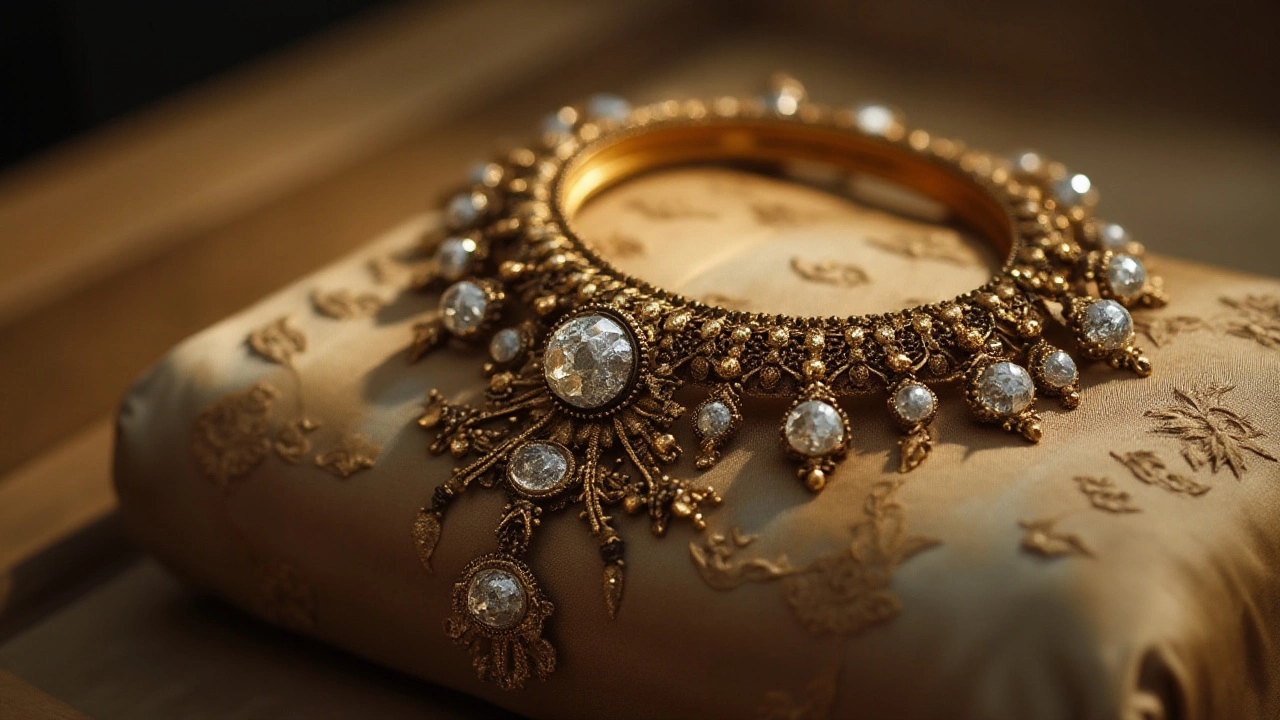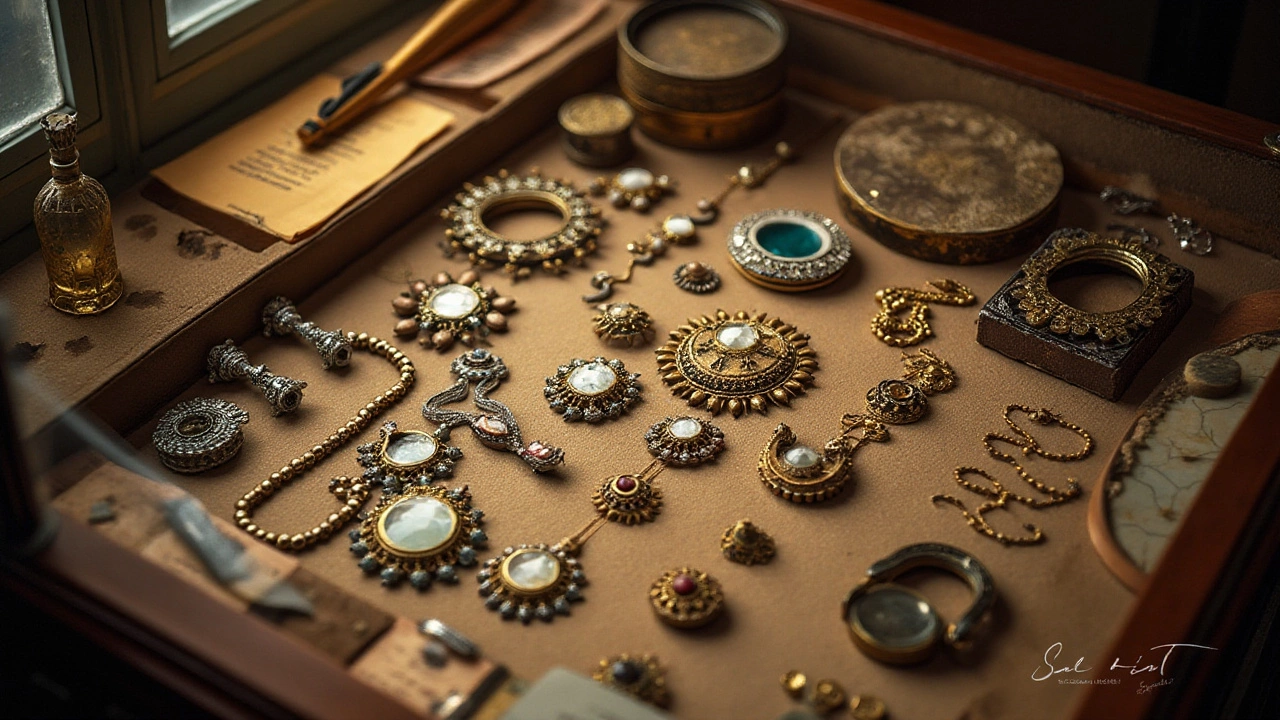When you think of diamonds, images of brilliant-cut, sparkling gems likely dance in your mind. But there exists an artful world beyond the polished stones we're used to seeing—a realm where beauty lies in the earth's untouched creations. Welcome to the enchanting world of the miner's diamond, where history meets raw charm.
The term 'miner's diamond' might sound rugged, yet it signifies something genuinely captivating. These are the stones as they appear naturally, before enduring the rigorous process of cutting and polishing. In their purest form, miner's diamonds offer a glimpse into the earth's artistry, displaying irregular shapes, cloudy hues, and an organic allure that polished counterparts sometimes lack.
This article will guide you through the identity and allure of these unique gems. We'll explore their place within the annals of antique jewelry design, touching on their historical roots and how they became beloved treasures. Additionally, we'll provide insights into identifying authentic miner's diamonds, a task made all the more rewarding by the stories these gems embody.
- Understanding the Miner's Diamond
- Historical Significance in Jewelry
- Identifying Authentic Pieces
- Collecting and Caring for Miner's Diamonds
- Cultural Narratives and Modern Appreciation
Understanding the Miner's Diamond
Picture this: a stone that embodies the very essence of nature's mystique, untouched by human precision, carrying the tales of its formation through millions of years. This is a miner’s diamond, the uncut and unpolished gemstone—a raw gem whose beauty lies in its imperfections and idiosyncrasies. Known for their rugged allure and distinct character, these diamonds have been cherished for centuries by those who value authenticity and history. When held up to the light, each facet, despite not being meticulously cut, reflects the unique journey the diamond undertook, telling the story of deep geological processes.
One might think that such diamonds are a modern fascination; however, their roots can be traced back to antiquity. In times when diamond cutting techniques were rudimentary or non-existent, these antique jewelry designs were celebrated for retaining the natural form of the gem. They symbolized purity and durability, admired for their ability to withstand the test of time. The miner's diamond essentially became a testament to the earth's inherent artistry, revered not just for its potential brilliance but also for its intrinsic mystery and fortitude.
Collectors and connoisseurs often speak of the delicate balance between the untouched beauty of these diamonds and the skill required to showcase them in jewelry. Unlike modern pieces, where the cut often dictates value, the value of a miner's diamond is intrinsic and historic. As noted by renowned gemologist Richard T. Liddicoat, "The natural beauty of these uncut diamonds is captivating. Their simplicity tells a story that the brilliant cut can sometimes overshadow."
"Their simplicity tells a story that the brilliant cut can sometimes overshadow," noted renowned gemologist Richard T. Liddicoat.
For those intrigued by geology, these stones offer a fascinating glimpse into our planet’s age-old systems. They are often diagramed in educational contexts to illustrate the formation of diamonds deep within the Earth’s mantle. To many, every blemish and cloud within a miner's diamond speaks of molten magma, crushing pressure, and eons of geological shifts. It's no wonder that many choose to retain these gems in their natural state when incorporating them into jewelry, as flaunting a miner’s diamond represents a nod to the vast history and power of nature, revered not only by jewelers but by historians and collectors alike.
Historical Significance in Jewelry
The history of antique jewelry brims with tales of artistry, craftsmanship, and cultural evolution, with the miner's diamond playing a fascinating part. For centuries, these unpolished gems have captured the imaginations of those who seek authenticity and the raw allure of nature's creations. The use of miner's diamonds dates back to an era when cutting techniques were limited, and the natural forms of the diamonds themselves dictated the design.
In ancient civilizations, from India to Rome, these diamonds were often left uncut, their rough surfaces treasured for the mystical properties they were believed to possess. In fact, during the classical period in Rome, uncut diamonds were worn as amulets, thought to provide protection and courage. As tales of kingdoms and empires unfolded over time, the miner's diamond retained its symbolic significance, rooted in folklore and myth that crossed geographical borders. Some records indicate that the Greeks considered diamonds as fragments of stars fallen to earth, lending them an ethereal aspect that elevated their worth.
By the Renaissance, the function of diamonds in jewelry began transforming dramatically. Yet, initial pieces were predominantly designed with minimal alterations to the stone's natural form. This era saw innovative metallurgy techniques that were pivotal in crafting settings that could accommodate the unique shapes of miner's diamonds, sparking an artistic revolution in jewelry design. This period also fostered a burgeoning interest in nature-inspired aesthetics, mirroring the raw elegance these stones represent.
"The allure of a miner's diamond is found not in its polish, but in its untouched beauty," mentioned renowned gemologist Dr. Michael Levitz during an exhibition on historical gemstones.
The Industrial Revolution birthed new cutting technologies, yet there remained purists who cherished miner's diamonds for their original state, associating them with an ancient, untamed beauty. Victorian-era jewelers often incorporated miner's diamonds into cherished heirlooms, setting them in intricate jewelry pieces that told stories of familial lineage and love. These gems, with their unrefined grace, stood as icons of endurance, bridging generations through their enduring charm.
Today, miner's diamonds continue to resonate with collectors and artisans who value history and authenticity as much as the aesthetic itself. As they weave through the narratives of time, miner's diamonds underscore a crucial fact: beauty need not always be polished; sometimes, it is found right as nature intended.

Identifying Authentic Pieces
When it comes to embracing the authentic artistry of a miner’s diamond, discerning genuine pieces from imitations or lesser grades can be a delicate art in itself. The allure of unrefined gems lies not only in their appearance but also in the stories they tell from beneath the earth's crust to their current resting places in heirloom jewels. For the keen-eyed collector or enthusiast, understanding the distinguishing features of a miner’s diamond is an invaluable skill that enhances appreciation and validates investments.
One vital aspect of differentiating a genuine miner's diamond lies in recognizing its natural characteristics. These stones, unlike their polished counterparts, are marked by imperfections — blemishes that narrate tales of their origin. Inspecting a diamond's inclusions, which are the internal 'birthmarks' of the stone, can provide critical insights. Authentic stones often show irregularities, like feather-like structures or minuscule imperfections. These are not flaws but rather the mineral's unique footprint, untouched and raw.
Another hallmark of a true miner's diamond is its inherent color and transparency. While many associate diamonds with a clear, colorless appearance, a miner's diamond can come in subtle shades and opacities that add to its beauty. Depending on trace elements and the conditions of formation, these gems may exhibit hues ranging from faint yellows to browns, and even into greys. The subtle variations in color and the cloudy appearance add a mystique that is prized by aficionados of antique jewelry.
Documentation and provenance also play a crucial role in ascertaining authenticity. Certificates of origin and detailed documentation can trace a diamond's journey, confirming its status and often increasing its worth. Reputable jewelers and auction houses typically offer guarantees or provenance records to support the gem's authenticity. Buying from renowned and trusted sources ensures that the history accompanying the stone is as valid as the piece itself, providing peace of mind and historical context.
A key strategy in differentiating authentic miner’s diamonds involves consulting specialists and seasoned collectors. Renowned gemologists stress the importance of educating oneself. They often provide consultations or host workshops to educate the public about telling markers of genuine stones. As Sophia Bennett from the International Gem Society once noted,
"In the realm of unpolished gems, the naked eye can sometimes deceive. It is the trained eye that unlocks the tale embedded in the stone's core."Collaboration with experts ensures not only proper identification but can also guide care practices to preserve the gem's natural state.
Finally, using technological aids to analyze the stone can provide clarity and confirmation. Tools such as magnifying lenses, spectrometers, and ultraviolet lights serve to illuminate aspects of the gem that aren't visible to the naked eye. For instance, ultraviolet light can reveal certain fluorescence that might indicate a diamond's source, and a careful examination with proper tools can validate characteristics that are akin to miner's diamonds. Employing such technology combines the wisdom of human expertise with the precision of modern methods.
In summation, identifying a genuine miner's diamond requires a harmonious blend of knowledge, historical understanding, keen perception, and trusted guidance. When you know where to look and what to look for, these untouched beauties present authentic stories silently held since time immemorial, offering not just an investment but a piece of nature’s profound artistry. Whether it is the gleam beneath the unpolished surface or the significance in handed-down lore, miner's diamonds invite wearers to experience the untamed and unrefined elegance of the earth's timeless creations.
Collecting and Caring for Miner's Diamonds
When someone embarks on the captivating journey of collecting miner’s diamonds, they’re diving into a world layered with history and filled with stories whispered through the ages. It’s not just about owning a piece of nature’s marvel; it’s about cherishing artifacts forged over millions of years. These gems, cherished for their raw beauty and individuality, are distinct in their unpolished state, making them a collector's delight. The art of assembling a collection requires not only a keen eye for detail but also a profound appreciation for what these stones represent. Each miner's diamond is truly unique, possessing irregularities that tell tales of their natural origin.
To start building a collection, potential collectors must educate themselves about the variety of antique jewelry designs that prominently feature these gems. Recognizing the differences between authentic and synthetic pieces is crucial. Unlike modern diamonds, miner's diamonds typically exhibit imperfections that add to their character—tiny occlusions, a hint of color, or an uneven surface. A piece's provenance often enhances its appeal, as these gems frequently carry the weight of family histories and past civilizations within their multitudes.
One fascinating aspect of these gems is their resilient nature. However, proper care is critical to ensure they remain as brilliant and storied as when first unearthed. Regular cleaning ensures that dirt and oils do not diminish their natural glow. Use mild soap and warm water to gently cleanse the dirt away, followed by a soft brush to remove grime from any grooves or carvings in the setting. Once clean, pat the jewel dry with a soft cloth. It’s essential to store them individually, as these stones can scratch other jewelry. For added protection, wrapping each piece in a silk or velvet pouch can prevent unwanted scratches or damage.
Consider seeking the advice of a reputable jeweler who specializes in antique jewels to evaluate and restore any pieces that have lost their luster over time. According to jewelry expert Clara Fisher, "Maintaining the integrity of miner's diamonds starts with understanding their historical context and craftsmanship." Their knowledge can provide peace of mind that your collection is well-preserved. A lasting point of pride among collectors is not just the gems themselves but the narratives and journeys each stone brings to their collection. Reflecting on how these stories weave through personal histories underscores their enduring significance.
The trend of collecting these vintage designs continues to grow, and their market value is steadily appreciating. As more people discover the beauty and heritage of miner’s diamonds, the demand for them increases. Investing time to understand the ebb and flow of this niche market will ensure collectors make informed decisions. Interestingly, data from a recent survey by the Antique Jewelry Association shows a 20% increase in interest and acquisition of miner’s diamond pieces over the past decade. Such statistics illustrate their rising popularity among both seasoned and novice collectors alike. With careful attention and a love for history's charm, your miner's diamond collection can blossom into a legacy cherished by generations to come.

Cultural Narratives and Modern Appreciation
Miner's diamonds have always been more than just stones; they weave stories that reflect both the history of mining and the quest for beauty in its most pristine form. These diamonds, often untouched by modern tools, evoke tales from a past where craftsmanship meant embracing nature's offerings as they were. Across cultures, these stones have been revered not just for their value, but for what they symbolize—purity, endurance, and a palpable linkage to the Earth's heart.
In the age before modern jewelry cutting techniques, rough diamonds had a different role. They weren't just monetary assets but symbols of power and connection. Across India, for instance, rough diamonds were seen as conduits of spiritual energy, worn by royalty as talismans to ward off evils. In another part of the globe, African tribes viewed them as sacred, using them in ceremonies that connected their earthly existence with spiritual realms. This reverence was not just about the sparkle but about the raw, untouched truth that these stones brought to the fore.
Today, the appreciation for a miner’s diamond transcends mere aesthetics, blossoming into an admiration for authenticity. In a world where synthetic stones can mimic perfection, the distinct imperfections of a miner’s diamond—that cloudy shadow or uneven texture—are cherished features. Jewelry designers and collectors alike are realizing that these characteristics are signatures of an environmentally conscious choice, embracing sustainability by crafting adornments that require minimal alteration.
"A diamond that has remained unchanged since it left the earth tells a story that needs no embellishment," muses renowned jeweler Elaine Banks. "Its journey from formation to adornment is a testament to nature's timeline."
This perspective shift is not merely aesthetic; it's a substantial cultural shift toward a deeper acknowledgement of heritage and environmental stewardship. Modern jewelers are now fashioning pieces that highlight the rough diamond's distinctiveness rather than altering it, crafting heirlooms that speak to individualism and a connection to Earth's origins. Market data supports this notion, with an increase in consumer desire for such untouched gems. This pivot in demand positions miner’s diamonds not only as charming antiques but as sustainable choices that narrate timeless stories.
The market for antique jewelry designs has seen a notable upturn, with sales of uncut diamonds rising annually by nearly 12% in recent years, reflecting a growing appreciation for non-traditional beauty. This aligns with cultural movements that value sustainability and personal expression over conspicuous consumption. Whether set into an intricately designed brooch or simply displayed as a standalone stone, miner's diamonds captivate those who are mindful of their antique allure and the legacy they carry forward.



